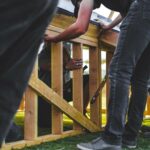Get ready to meet Frank Lentini, a real-life phenomenon born with an extra set of legs. He was like a human tripod, but Lentini didn’t let his unique physique define him. He became a circus star, a husband, a father, and an inspiration to people around the world. Join us as we explore the extraordinary life of Frank Lentini, the man who proved that being different can be the greatest superpower.
From Sicily to the Spotlight: Lentini’s Rise to Fame
Born in Rosolini, Sicily, in 1889, Frank Lentini’s life was anything but ordinary. Due to a parasitic twin that did not fully form in the womb, he was born with three legs, four feet, sixteen toes, and two sets of functioning male genitalia. It was an incredibly rare condition that could have led to a life of hardship and isolation.
Initially rejected by his family, young Frank was sent to an institution for children with disabilities. However, within the walls of that institution, a profound shift occurred: Lentini began to view his extra limb not as a burden, but as a unique gift. This change in perspective would define his path forward.
At the age of eight, Lentini’s journey took him from Sicily to the United States. He joined a traveling puppet show, where his extraordinary physique undoubtedly captivated audiences. This marked the beginning of his remarkable career in show business.
More Than a Spectacle: Lentini’s Circus Stardom
Lentini’s career flourished as he became a headlining act in various circuses, including the iconic Ringling Bros. and Barnum & Bailey Circus. His act, often billed as “The Great Lentini,” went beyond mere spectacle. While his three legs were certainly an attention-grabber, Lentini possessed a remarkable agility and charisma that truly resonated with audiences.
He was renowned for his physical dexterity, even demonstrating his skills by kicking a soccer ball with surprising accuracy using his third leg. However, it was his humor and charm that truly set him apart. Lentini embraced his difference, making light of his extra leg with witty jokes that turned potentially awkward moments into roars of laughter.
A Life Beyond the Limelight: Marriage, Family, and Resilience
Behind the dazzling lights and roaring crowds, Frank Lentini yearned for a life beyond the stage. In 1907, he married Theresa Murray, and together they had four children. The details of their family life remain largely private, but their union serves as a powerful testament to Lentini’s desire for a normal and fulfilling personal life, defying the limitations often placed upon people with disabilities.
Tragically, Theresa passed away in 1935. However, in a testament to his resilient spirit and capacity for love, Lentini married again. Though information about his second wife remains scarce, his decision to remarry speaks volumes about his need for companionship and a sense of belonging – desires shared by us all.
Lentini’s story is a profound reminder that happiness and fulfillment can be found beyond societal norms. He was more than just a medical marvel; he was a man who sought and found love, connection, and the joys of family life.
A Legacy of Acceptance and Overcoming Adversity
Frank Lentini, the “Three-Legged Wonder,” lived a remarkably long life, passing away in 1966 at the age of 77. His longevity is especially noteworthy given the potential health challenges associated with his condition.
More than just a circus performer, Lentini became a symbol of resilience and the power of self-acceptance. He challenged societal perceptions of disability, proving that difference could be extraordinary and that limitations were often self-imposed. Lentini’s story continues to inspire, urging us to embrace our individuality, confront challenges with optimism, and discover joy in the most unexpected of places.
While many questions about the specifics of Lentini’s personal life and medical journey remain, his impact on the world is undeniable. He shifted the conversation surrounding physical differences, paving the way for greater understanding and acceptance for generations to come.
- Unveiling the Enigma: Mansoureh Khojasteh Bagherzadeh’s Public Appearances & Private Life in Iran - July 18, 2025
- Unveiling the Mystery: Mansoureh Khojasteh Bagherzadeh’s Husband: A Rare Glimpse into a Private Life - July 18, 2025
- Unveiling Masoud Khamenei’s Mother: Power, Influence, and Iran’s Future - July 18, 2025















